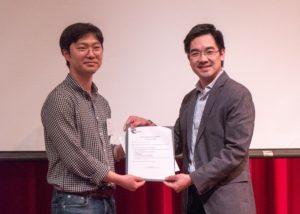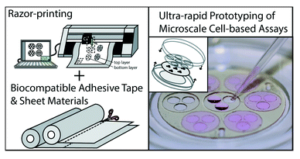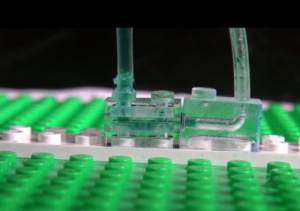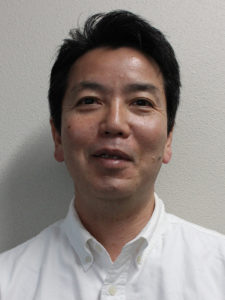We are delighted to introduce our latest Lab on a Chip Emerging Investigator, Edmond Young!
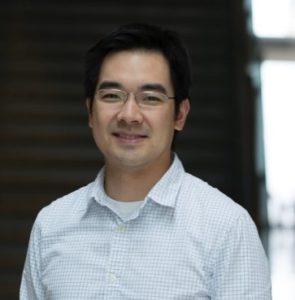 Dr. Edmond Young joined the Department of Mechanical & Industrial Engineering at the University of Toronto as an Assistant Professor in January 2013. He received his BASc (2001) and MASc (2003) in Mechanical Engineering at the University of British Columbia, and his PhD in Mechanical and Biomedical Engineering at the University of Toronto (2008). He was a postdoctoral fellow at the University of Wisconsin-Madison from 2009 to 2012, working at the Wisconsin Institute for Medical Research (WIMR). Professor Young’s research interests focus on the development of microscale technologies for cell biology applications, with emphasis on creating engineered models that mimic the cell and tissue microenvironments in both healthy and diseased animals. He received the Governor General’s Gold Medal and the Norman F. Moody Award for academic excellence in 2009, the MIE Early Career Teaching Award in 2015, the Ontario Early Researcher Award and Connaught New Investigator Award in 2016, and has been recognized as an Outstanding Reviewer for Lab on a Chip in both 2016 and 2017.
Dr. Edmond Young joined the Department of Mechanical & Industrial Engineering at the University of Toronto as an Assistant Professor in January 2013. He received his BASc (2001) and MASc (2003) in Mechanical Engineering at the University of British Columbia, and his PhD in Mechanical and Biomedical Engineering at the University of Toronto (2008). He was a postdoctoral fellow at the University of Wisconsin-Madison from 2009 to 2012, working at the Wisconsin Institute for Medical Research (WIMR). Professor Young’s research interests focus on the development of microscale technologies for cell biology applications, with emphasis on creating engineered models that mimic the cell and tissue microenvironments in both healthy and diseased animals. He received the Governor General’s Gold Medal and the Norman F. Moody Award for academic excellence in 2009, the MIE Early Career Teaching Award in 2015, the Ontario Early Researcher Award and Connaught New Investigator Award in 2016, and has been recognized as an Outstanding Reviewer for Lab on a Chip in both 2016 and 2017.
Read Edmond’s Emerging Investigator series paper “Microfluidic lung airway-on-a-chip with arrayable suspended gels for studying epithelial and smooth muscle cell interactions” and find out more about him in the interview below:
Your recent Emerging Investigator Series paper focuses on lung airway-on-a-chip. How has your research evolved from your first article to this most recent article?
This is actually our first article on this specific project, and we’re excited to share these results with the Lab on a Chip readership, and others doing lung-on-a-chip research. I can think back to a few articles on thermoplastic microfabrication that our lab published (Guckenberger et al., Lab Chip, 2015; Wan et al., Lab Chip, 2015; Wan et al., JoVE, 2017), which really enabled us to fabricate our current airway-on-a-chip device consistently and repeatably. Developing reliable fabrication methods gave us the confidence needed to do these long-term cultures without constantly worrying about fabrication challenges. Now, our lab can fabricate and keep devices “in stock” well ahead of the biology experiments, and that in itself has been a bit of an evolution in our lab and also in the field.
What aspect of your work are you most excited about at the moment?
I’m most excited about the ongoing collaborations with engineers and doctors who are interested in using the platform for their own work. The technology still has a lot of room for development, but hearing how the system may be applied to lung research, and potentially other biology questions, is very exciting and motivating.
In your opinion, what is the biggest impact your developed lung airway-on-a-chip could have on our understanding of chronic lung diseases?
I think the biggest impact will be learning about the differences in biological responses of the various in vitro and ex vivo airway models, against which we plan to benchmark our model. The promise of organ-on-a-chip technology lies in its ability to mimic human tissue more accurately, and if our model can continue to advance as planned, we envision making new observations with our device that could not have been made with conventional models. And if we do find interesting differences, it will build on the growing evidence that traditional platforms such as 2D Transwells for coculture do not properly recapitulate the in vivo microenvironment. Many scientists will need to rethink their approach to in vitro experiments (if they haven’t done so already), and decide what models are most representative and most useful.
What do you find most challenging about your research?
The most challenging aspect of my research overall is trying to keep pace with the field. It is a rapidly evolving area of research with many amazing scientists and engineers making important contributions. Research takes time and patience, so another constant challenge is managing students who are just learning about the effort, resilience, and patience needed to make something work in research. But it’s well worth it when you see the results, both in terms of the research and in terms of student development.
In which upcoming conferences or events may our readers meet you?
I’ll be in Whistler from May 9-11, 2018 for an Emerging Technologies Conference, back in Toronto to co-chair the Ontario-on-a-Chip Symposium from May 24-25, 2018 (Lab on a Chip is our sponsor this year!), and plan to be at microTAS 2018 in Taiwan.
How do you spend your spare time?
I play a little tennis (seasonally in Toronto’s climate), but my latest source of amusement when I have spare time is my 11-month-old daughter Amelia. When she’s old enough, I will surely convince her to get into tennis (and hockey) so that her dad can live vicariously through her athletic pursuits! And if she happens to fall in love with research, I’d be pleased with that too.
Which profession would you choose if you were not a scientist?
I considered being an architect when I was younger, and I still get excited when I hear of the latest buildings and structures around the world that are being built. I like the technical engineering aspects of it, of course, but I also like how they define the skyline of big cities, and how art, culture, and engineering all come together in some of the world’s most beautiful architecture.
Can you share one piece of career-related advice or wisdom with other early career scientists?
Surround yourself with great people. That applies to your friends, mentors, colleagues, and importantly, your students. And let them all challenge you so that your ideas are pressure-tested.


